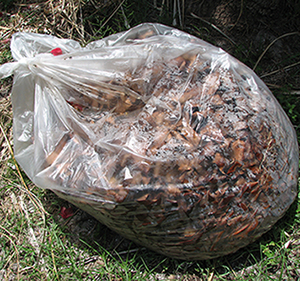For The Best Composting Materials Learn to Scrounge Around

Leaves Found at Curb
Now that you are composting you will probably look at your world differently. Many people who come talk to me when they first start composting say they are having trouble finding carbonaceous composting materials. For the best composting materials you have to learn to scrounge around. That is you have to start looking at what your neighbors are putting out at the curb. Most people put their actual garbage in bags in cans, so if you see bags out there not in cans and there are also lidded cans it may mean that there are leaves in those bags. Usually a gentle kick will tell you what’s in the bag. Lots of my neighbors put leaves in open cans. It is very easy to see, and when I do I just walk on down there with some leaf bags and dump out the cans. Um, don’t forget dogs will pee on stuff left at the curb. Keep some gloves and some newspaper in your vehicle so you are ready to scrounge some stuff when you see it.
You need leaves, but even if you wind up with a couple of bags of pine needles which you would not add to your compost pile you can for sure use them for something. I have a compost pile that is just for pine needles.. eventually that makes good acidic pine mulch which is excellent for blueberries. I also have areas where I need to mulch for walkways. Pine needles make great walkways. Maybe you have a neighbor with a pet rabbit or hamster. Your kids may know other kids with those sort of pets. Their bedding makes excellent compost, and you would be keeping that stuff out of the landfill.
Scrounging around is not a bad thing, and most people don’t mind at all if you walk or drive away with some part of their yard wastes. I also take palm logs if it looks like they were from a live tree (I don’t want to bring in a palm disease so I don’t take stuff that looks like it died before it was cut down). What do I do with Palm Logs? See my Palm Post article.
One friend told me she doesn’t think anyone in her neighborhood is raking up leaves. I guess if you live in a real rural area that might be true, but I think the more quaffed a neighborhood is, the more likely people are raking up everything that falls to the ground and putting it out at the curb. You just have to tune in to see it. If neighbors are using a landscaping service you just may have to catch the landscaper before he hauls off the leaves. If this just isn’t happening in your neighborhood then cruise through another neighborhood when you are nearby for an errand. FYI locals, I live in IRE and most anytime I walk or drive thru my neighborhood I find great quantities of great leaves left for Wednesday morning pickup. One day my neighbor and I filled the backs of both our vans at one property. We were rich!
Because it is hot now I see less yard wastes out at the curb. Your neighbors will pick a beautiful day to work out in the yard. When that beautiful day falls on a weekend you are going to find lots of bags. Watch for leaf bags starting in October. If you are doing some tree or shrub pruning lay your cuttings on the ground in the sun and wait for the leaves to fall from the branches before moving the wood to the passive compost pile. You can get a good batch of leaves that way. Give them a few weeks on the ground to turn brown.
Lets go over all of the things other than brown leaves that will add carbon to your compost pile. Grass clippings that have been left to dry out in the sun for a few weeks are a decent carbon source. Shredded newspapers work great and the inks are soy based, so no worries there, just don’t use the shiny pages. I have always found lots of worms in the newspaper that gets into my compost. Saw Dust from untreated wood is extremely carbonaceous just be careful to add it lightly and mix it in well otherwise sawdust tends to clump up and block oxygen. Dried Palm Fronds make a great carbonaceous additive for compost but you will have to chip them up. The leaf parts you can chop up by hand pretty quickly with a hedge shear. Straw is a great carbon additive and it tends to keep the compost light and oxygenated, but I would take the time to chop it up like with the lawn mower. Old hay is carbonaceous, as is most mammal cage bedding. Coffee grounds and coffee filters are carbonaceous too.
If you just can’t bring yourself to scrounge around, or you just don’t see what you are looking for then let me know. I pack bunny cage cleanings into empty pine flake bags for resale. They contain pine flake, hay and rabbit manure and they sell for two bucks. To find me go to my consulting page for contact information.
All joking aside this world was made to regenerate itself. When trees and plants drop their leaves on the ground they set in motion the cycle of decomposition that makes it possible for life to go on. Raking up leaves from the ground on your land is a shame. Bagging them to be taken off property is a crime. When you pick up your neighbors’ leaves from the curb you are doing your part to erase that crime.
Now go fight crime.
